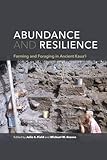Abundance and Resilience : Farming and Foraging in Ancient Kaua'i / ed. by Julie S. Field, Michael W. Graves.
Material type: TextPublisher: Honolulu : University of Hawaii Press, [2015]Copyright date: ©2015Description: 1 online resource (288 p.) : 53 black & white illustrationsContent type:
TextPublisher: Honolulu : University of Hawaii Press, [2015]Copyright date: ©2015Description: 1 online resource (288 p.) : 53 black & white illustrationsContent type: - 9780824839895
- 9780824857158
- 333.950996941 23
- DU624.A26 2015
- online - DeGruyter
- Issued also in print.
| Item type | Current library | Call number | URL | Status | Notes | Barcode | |
|---|---|---|---|---|---|---|---|
 eBook
eBook
|
Biblioteca "Angelicum" Pont. Univ. S.Tommaso d'Aquino Nuvola online | online - DeGruyter (Browse shelf(Opens below)) | Online access | Not for loan (Accesso limitato) | Accesso per gli utenti autorizzati / Access for authorized users | (dgr)9780824857158 |
Frontmatter -- Contents -- List of Figures -- List of Tables -- Acknowledgments -- Abbreviations -- Chapter 1. Introduction -- Chapter 2. Nu'alolo Kai in Context -- Chapter 3. Excavations and Investigations at Site 50-30-01-196, Nu'alolo Kai, 1958-1990 -- Chapter 4. Temporal Changes in Fishing Strategies at Nu'alolo Kai -- Chapter 5. Modified and Unmodified Turtle Remains from Nu'alolo Kai -- Chapter 6. Avifauna from Nu'alolo Kai -- Chapter 7. Introduced and Native Mammals from Nu'alolo Kai -- Chapter 8. Modified Coral from Nu'alolo Kai -- Chapter 9. Shell, Bone, and Invertebrate Ornaments from Nu'alolo Kai -- Chapter 10. Applied Zooarchaeology and Conservation Biology at Nu'alolo Kai -- Chapter 11. Synthesis: The Prehistory of Nu'alolo Kai -- Appendix A: Fish Remains from the 1990 Excavations at Nu'alolo Kai -- Appendix B: Other Faunal Tools and Modified Materials from Nu'alolo Kai -- Appendix C: Unmodified Invertebrate Remains from Nu'alolo Kai -- References -- Contributors -- Index
restricted access online access with authorization star
http://purl.org/coar/access_right/c_16ec
At the base of a steep cliff towering some 500 feet above the coast of the remote Nā Pali district on the island of Kaua'i, lies the spectacular historical and archaeological site at Nu'alolo Kai. First excavated by Bishop Museum archaeologists between 1958 and 1964, the site contained the well-preserved remains of one of the largest and most diverse arrays of traditional and historic artifacts ever found in Hawai'i. The house sites that constitute the focus of Abundance and Resilience were built over five centuries of occupation and contained deeply buried, stratified deposits extending more than nine feet beneath the surface. The essays in this volume detail the work of archaeologists associated with the University of Hawai'i who have been compiling and studying the animal remains recovered from the excavations. The contributors discuss the range of foods eaten by Hawaiians, the ways in which particular species were captured and harvested, and how these practices might have evolved through changes in the climate and natural environment. Adding to this are analyses of a sophisticated material culture-how ancient Hawaiians fashioned animal remains into artifacts such as ornaments made of shell, pointed bird bone "pickers," sea urchin and coral files and abraders, turtle shell combs, and bone handles for kāhili (feathered standards) used by Hawaiian royalty. For researchers, Nu'alolo Kai opened up the world of everyday life of indigenous Hawaiians between AD 1400 and 1900. More importantly, we learn how their procurement and utilization of animals-wild marine organisms and birds, as well as domesticated dogs and pigs-affected local resources. Demonstrating that an increased preference for introduced animals, such as dogs and pigs, effectively limited negative impacts on wild animal resources, the essays in Abundance and Resilience collectively argue that the Hawaiian community of Nu'alolo Kai practiced a sustainable form of animal resource procurement and management for five centuries.
Issued also in print.
Mode of access: Internet via World Wide Web.
In English.
Description based on online resource; title from PDF title page (publisher's Web site, viewed 02. Mrz 2022)


